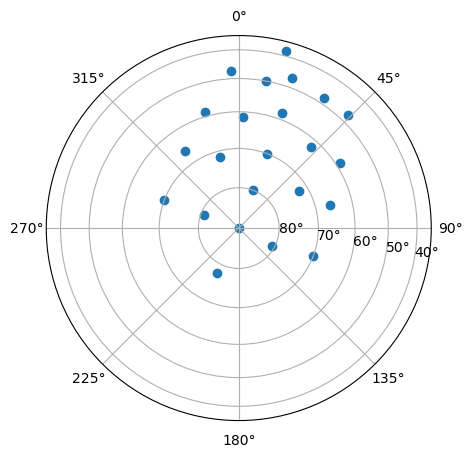Common Plots#
The following examples show how to create some common visualizations of Madrigal data. Due to the 4D nature of the data, it is challenging to visualize all parts of the FoV simultaneously.
import h5py
import numpy as np
import matplotlib.pyplot as plt
import os
import madrigalWeb.madrigalWeb
madrigalUrl='http://cedar.openmadrigal.org'
data = madrigalWeb.madrigalWeb.MadrigalData(madrigalUrl)
user_fullname = 'Student Example'
user_email = 'isr.summer.school@gmail.com'
user_affiliation= 'ISR Summer School 2024'
code = 61 # PFISR
year = 2024
month = 1
day = 8
hour1 = 7
minute1 = 1
hour2 = 13
# list of experiments inside a time period of a day
expList = data.getExperiments(code,year,month,day,hour1,minute1,0,year,month,day,hour2,0,0)
for exp in expList:
print(str(exp))
id: 100278619
realUrl: http://cedar.openmadrigal.org/showExperiment/?experiment_list=100278619
url: http://cedar.openmadrigal.org/madtoc/experiments4/2024/pfa/08jan24a
name: Themis36 - Auroral and convection measurements
siteid: 10
sitename: CEDAR
instcode: 61
instname: Poker Flat IS Radar
startyear: 2024
startmonth: 1
startday: 8
starthour: 7
startmin: 1
startsec: 4
endyear: 2024
endmonth: 1
endday: 8
endhour: 18
endmin: 0
endsec: 0
isLocal: True
madrigalUrl: http://cedar.openmadrigal.org/
PI: Asti Bhatt
PIEmail: asti.bhatt@sri.com
uttimestamp: 1709109883
access: 2
Madrigal version: 3.2
fileList = data.getExperimentFiles(expList[0].id)
for file0 in fileList:
print(os.path.basename(file0.name),'\t', file0.kindat, '\t',file0.kindatdesc)
pfa20240108.001_ac_nenotr_01min.001.h5 1000201 Ne From Power - Alternating Code (E-region) - 1 min
pfa20240108.001_ac_fit_01min.001.h5 2000201 Fitted - Alternating Code (E-region) - 1 min
pfa20240108.001_ac_nenotr_03min.001.h5 1000203 Ne From Power - Alternating Code (E-region) - 3 min
pfa20240108.001_ac_fit_03min.001.h5 2000203 Fitted - Alternating Code (E-region) - 3 min
pfa20240108.001_ac_nenotr_05min.001.h5 1000205 Ne From Power - Alternating Code (E-region) - 5 min
pfa20240108.001_ac_fit_05min.001.h5 2000205 Fitted - Alternating Code (E-region) - 5 min
pfa20240108.001_ac_nenotr_10min.001.h5 1000210 Ne From Power - Alternating Code (E-region) - 10 min
pfa20240108.001_ac_fit_10min.001.h5 2000210 Fitted - Alternating Code (E-region) - 10 min
pfa20240108.001_ac_nenotr_15min.001.h5 1000215 Ne From Power - Alternating Code (E-region) - 15 min
pfa20240108.001_ac_fit_15min.001.h5 2000215 Fitted - Alternating Code (E-region) - 15 min
pfa20240108.001_ac_nenotr_20min.001.h5 1000220 Ne From Power - Alternating Code (E-region) - 20 min
pfa20240108.001_ac_fit_20min.001.h5 2000220 Fitted - Alternating Code (E-region) - 20 min
pfa20240108.001_lp_nenotr_01min.001.h5 1000101 Ne From Power - Long Pulse (F-region) - 1 min
pfa20240108.001_lp_fit_01min.001.h5 2000101 Fitted - Long Pulse (F-region) - 1 min
pfa20240108.001_lp_nenotr_03min.001.h5 1000103 Ne From Power - Long Pulse (F-region) - 3 min
pfa20240108.001_lp_fit_03min.001.h5 2000103 Fitted - Long Pulse (F-region) - 3 min
pfa20240108.001_lp_nenotr_05min.001.h5 1000105 Ne From Power - Long Pulse (F-region) - 5 min
pfa20240108.001_lp_fit_05min.001.h5 2000105 Fitted - Long Pulse (F-region) - 5 min
pfa20240108.001_lp_nenotr_10min.001.h5 1000110 Ne From Power - Long Pulse (F-region) - 10 min
pfa20240108.001_lp_fit_10min.001.h5 2000110 Fitted - Long Pulse (F-region) - 10 min
pfa20240108.001_lp_nenotr_15min.001.h5 1000115 Ne From Power - Long Pulse (F-region) - 15 min
pfa20240108.001_lp_fit_15min.001.h5 2000115 Fitted - Long Pulse (F-region) - 15 min
pfa20240108.001_lp_nenotr_20min.001.h5 1000120 Ne From Power - Long Pulse (F-region) - 20 min
pfa20240108.001_lp_fit_20min.001.h5 2000120 Fitted - Long Pulse (F-region) - 20 min
pfa20240108.001_lp_vvels_01min.001.h5 3000101 Resolved Velocity - Long Pulse (F-region) - 1 min
pfa20240108.001_lp_vvels_03min.001.h5 3000103 Resolved Velocity - Long Pulse (F-region) - 3 min
pfa20240108.001_lp_vvels_05min.001.h5 3000105 Resolved Velocity - Long Pulse (F-region) - 5 min
# Download the file that we need to run these examples
os.makedirs('data', exist_ok=True)
filepath= 'data/pfa20240108.001_lp_fit_01min.001.h5 '
if not os.path.exists(filepath):
fileList = data.getExperimentFiles(expList[0].id)
for file0 in fileList:
if file0.kindatdesc == 'Fitted - Long Pulse (F-region) - 1 min':
file2download = file0.name
break
print('Downloading data file...')
file = data.downloadFile(file2download, filepath,
user_fullname, user_email, user_affiliation,'hdf5')
print('...Done!')
else:
print(f"File {filepath} already downloaded")
File data/pfa20240108.001_lp_fit_01min.001.h5 already downloaded
RTI Plot#
Range-Time-Intensity (RTI) plots are a common way to look at how profiles of a parameter change in time.
The Most Basic#
with h5py.File(filepath, 'r') as h5:
bidx = 'Array with beamid=63149 '
rng = np.array(h5['Data/Array Layout'][bidx]['range'])
ne = np.array(h5['Data/Array Layout'][bidx]['2D Parameters']['ne']).T
utime = np.array(h5['Data/Array Layout'][bidx]['timestamps'])
time = utime.astype('datetime64[s]')
fig = plt.figure(figsize=(10,5))
plt.pcolormesh(time, rng[np.isfinite(rng)], ne[:,np.isfinite(rng)].T, vmin=0., vmax=4.e11)
<matplotlib.collections.QuadMesh at 0x7fd9074b49a0>
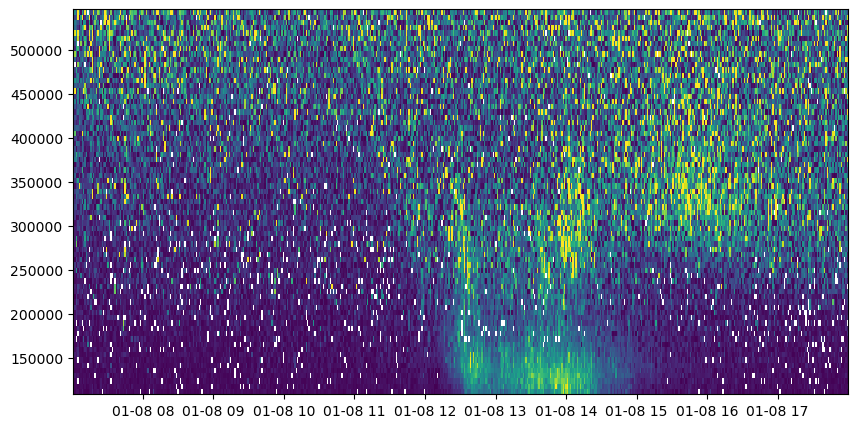
A Scientifically Useful Plot#
Now lets create the same plot as before but with intelligible axes and labels, a colorbar, ect. This is probably the minimum you want to do for inclusion in a paper or presentation.
with h5py.File(filepath, 'r') as h5:
bidx = 'Array with beamid=63149 '
rng = np.array(h5['Data/Array Layout'][bidx]['range'])
ne = np.array(h5['Data/Array Layout'][bidx]['2D Parameters']['ne']).T
utime = np.array(h5['Data/Array Layout'][bidx]['timestamps'])
time = utime.astype('datetime64[s]')
fig = plt.figure(figsize=(12,5))
ax = fig.add_subplot(111)
c = ax.pcolormesh(time, rng[np.isfinite(rng)], ne[:,np.isfinite(rng)].T, vmin=0., vmax=4.e11)
ax.set_xlabel('Universal Time')
ax.set_ylabel('Slant Range (m)')
fig.colorbar(c, label=r'Electron Density (m$^{-3}$)')
<matplotlib.colorbar.Colorbar at 0x7fd90a0075b0>
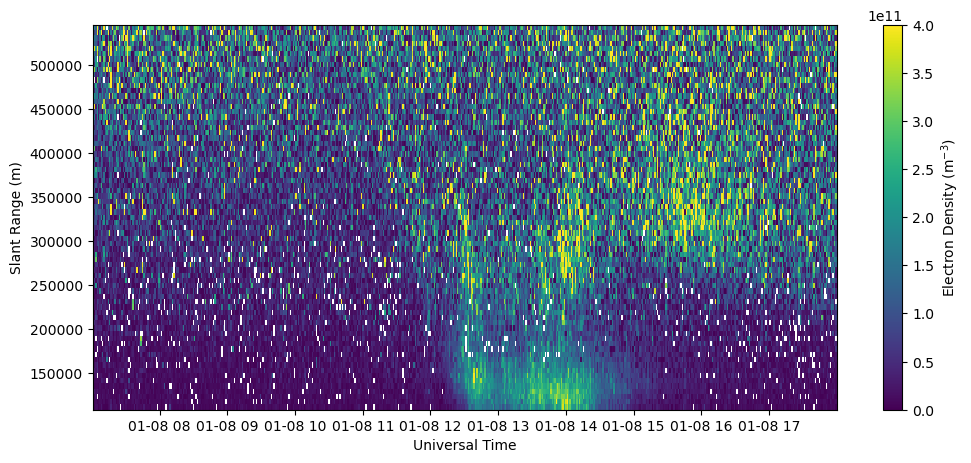
Plotting a Specific Beam#
Plot a specific beam by selecting the beam index (bidx) more carefully. You can either select a particular beam by its beamcode, or choose a beam based on proximity to a particular azimuth/elevation (i.e., choose the highest elevation beam in the beam pattern).
# Plot beam 64157
with h5py.File(filepath, 'r') as h5:
beamcodes = np.array(h5['Data/Array Layout'])
bidx = 'Array with beamid=64157 '
rng = np.array(h5['Data/Array Layout'][bidx]['range'])
ne = np.array(h5['Data/Array Layout'][bidx]['2D Parameters']['ne']).T
utime = np.array(h5['Data/Array Layout'][bidx]['timestamps'])
azm = h5['Data/Array Layout']['Array with beamid=63149 ']['1D Parameters']['azm'][0]
elm = h5['Data/Array Layout']['Array with beamid=63149 ']['1D Parameters']['elm'][0]
beamid = h5['Data/Array Layout']['Array with beamid=63149 ']['1D Parameters']['beamid'][0]
time = utime.astype('datetime64[s]')
fig = plt.figure(figsize=(12,5))
ax = fig.add_subplot(111)
c = ax.pcolormesh(time, rng[np.isfinite(rng)], ne[:,np.isfinite(rng)].T, vmin=0., vmax=4.e11)
ax.set_xlabel('Universal Time')
ax.set_ylabel('Slant Range (m)')
ax.set_title('Beam Number: {:.0f} (az:{:.1f}, el:{:.1f})'.format(beamid, azm, elm))
fig.colorbar(c, label=r'Electron Density (m$^{-3}$)')
<matplotlib.colorbar.Colorbar at 0x7fd907d9f310>
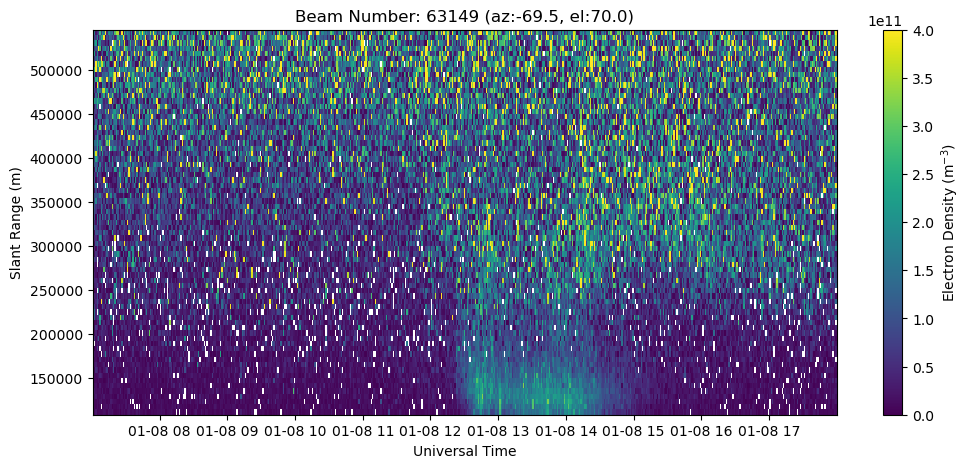
# Plot the highest elevation beam (vertical in this case)
with h5py.File(filepath, 'r') as h5:
elms = []
bmid = []
for key in h5['Data/Array Layout'].keys():
elms.append(np.array(h5['Data/Array Layout'][key]['1D Parameters']['elm'][0]))
bmid.append(np.array(h5['Data/Array Layout'][key]['1D Parameters']['beamid'][0]))
elms = np.array(elms)
bmid = np.array(bmid)
idx = np.argmax(elms)
max_beam = bmid[idx]
bidx = f'Array with beamid={max_beam} '
rng = np.array(h5['Data/Array Layout'][bidx]['range'])
ne = np.array(h5['Data/Array Layout'][bidx]['2D Parameters']['ne']).T
utime = np.array(h5['Data/Array Layout'][bidx]['timestamps'])
azm = h5['Data/Array Layout'][bidx]['1D Parameters']['azm'][0]
elm = h5['Data/Array Layout'][bidx]['1D Parameters']['elm'][0]
beamid = h5['Data/Array Layout'][bidx]['1D Parameters']['beamid'][0]
time = utime.astype('datetime64[s]')
fig = plt.figure(figsize=(12,5))
ax = fig.add_subplot(111)
c = ax.pcolormesh(time, rng, ne.T, vmin=0., vmax=4.e11)
ax.set_xlabel('Universal Time')
ax.set_ylabel('Slant Range (m)')
ax.set_title('Beam Number: {:.0f} (az:{:.1f}, el:{:.1f})'.format(beamid, azm, elm))
fig.colorbar(c, label=r'Electron Density (m$^{-3}$)')
<matplotlib.colorbar.Colorbar at 0x7fd907cfa410>
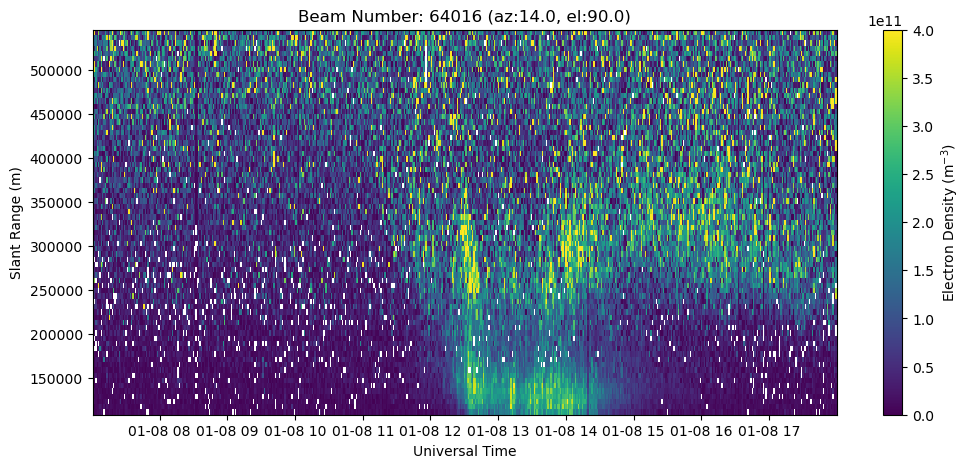
Beam Position Plot#
Create a polar plot of all beam positions for this particular experiment.
with h5py.File(filepath, 'r') as h5:
el = []
az = []
for key in h5['Data/Array Layout'].keys():
el.append(np.array(h5['Data/Array Layout'][key]['1D Parameters']['elm'][0]))
az.append(np.array(h5['Data/Array Layout'][key]['1D Parameters']['azm'][0]))
el = np.array(el)
az = np.array(az)
# set up plot
fig = plt.figure(figsize=(5,5))
ax = fig.add_subplot(111, projection='polar')
ax.set_theta_direction(-1)
ax.set_theta_offset(np.pi/2.0)
ax.set_rlabel_position(100.)
elticks = np.arange(20., 90., 10.)
ax.set_rticks(np.cos(elticks*np.pi/180.))
ax.set_yticklabels([str(int(el))+u'\N{DEGREE SIGN}' for el in elticks])
ax.scatter(az*np.pi/180., np.cos(el*np.pi/180.))
<matplotlib.collections.PathCollection at 0x7fd907ba6e00>
